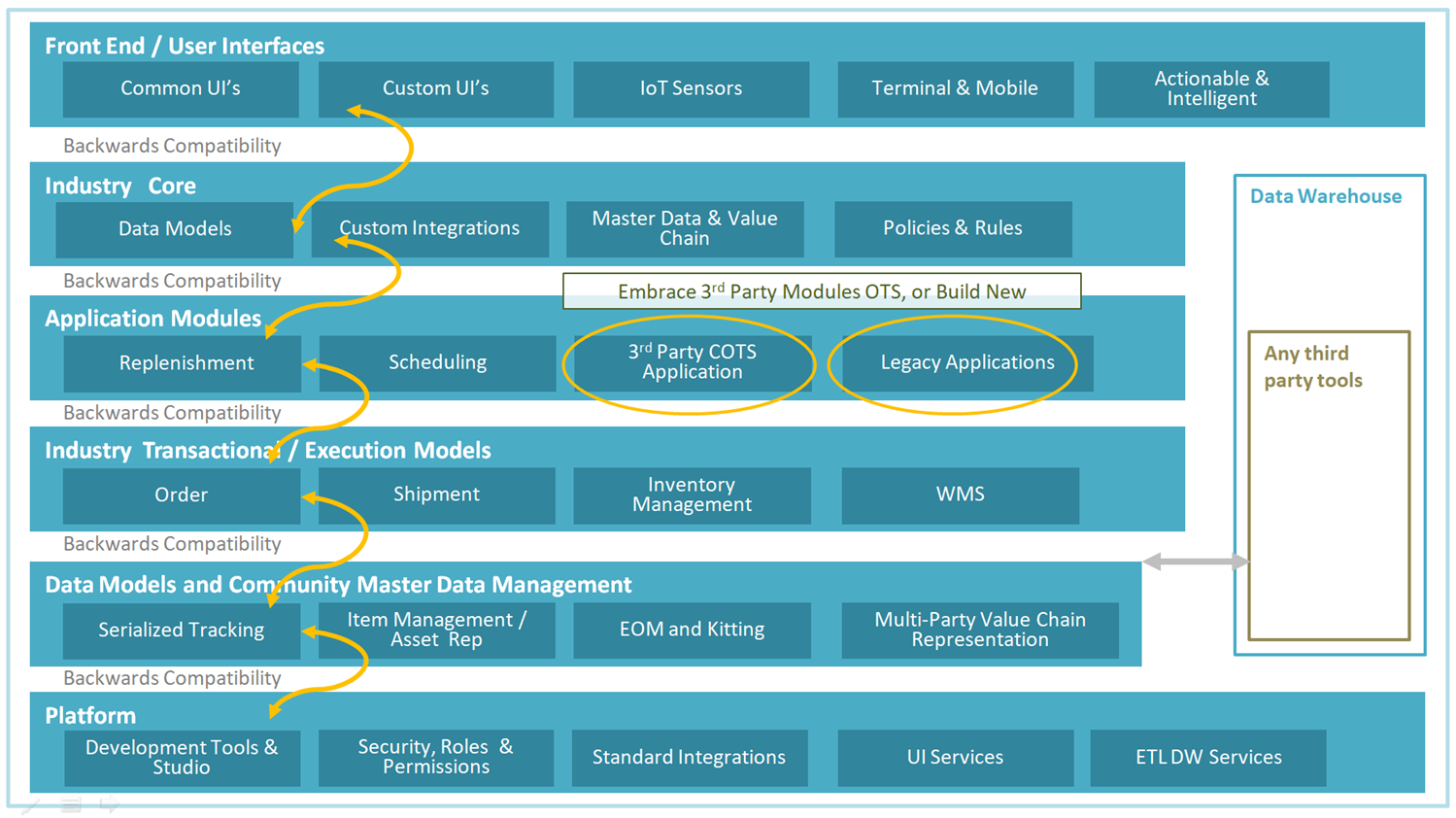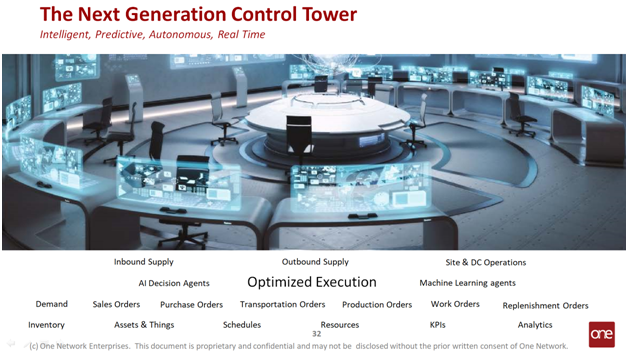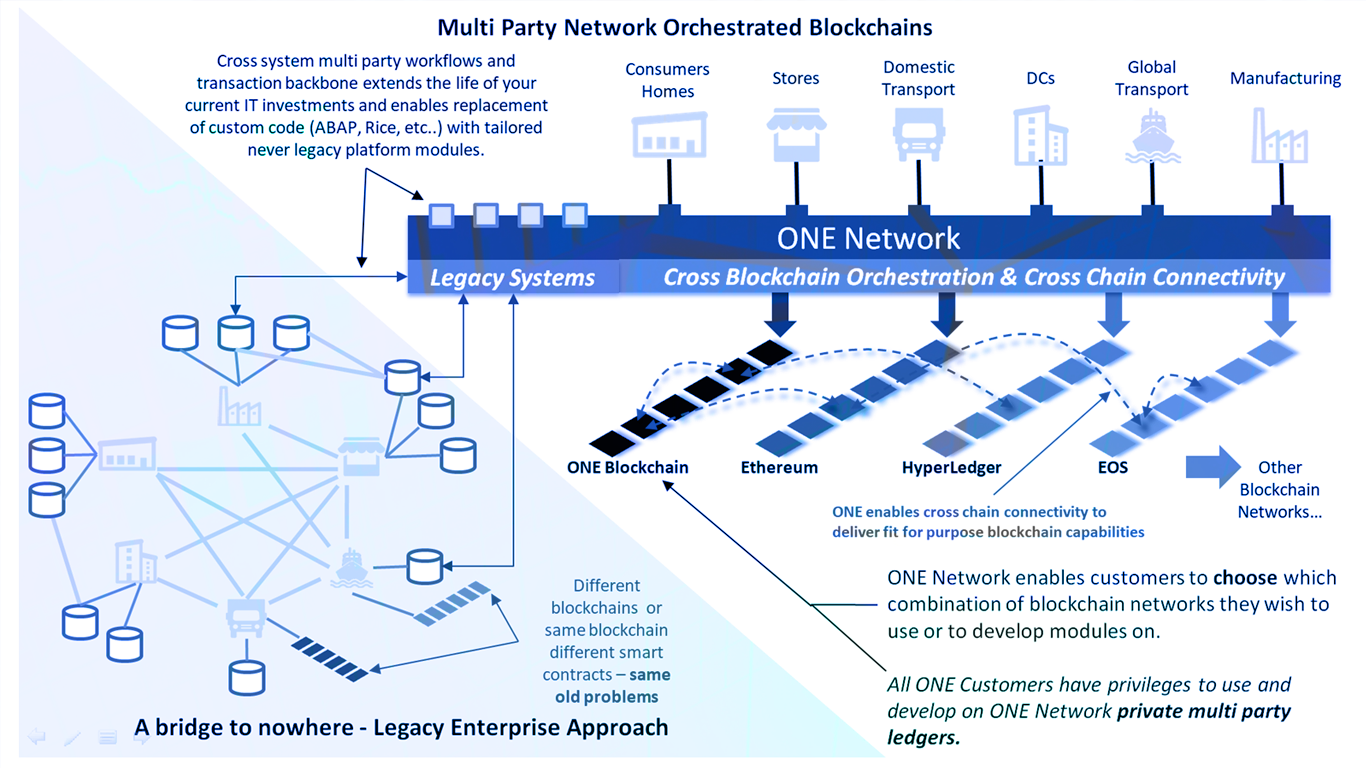This post has already been read 14442 times!
In Enterprise Journey to Blockchain Part 1 I discussed the threat of disruption that blockchain poses to many companies today. I discussed some of the differences between the traditional enterprise world and the multi-party network model of blockchain. In Enterprise to Journey to Blockchain Part 2 we looked at some of the key difference between enterprise solutions and networks. In Enterprise Journey to Blockchain Part 3 we looked at a way to bridge the gap from enterprise to multiparty networks.
Let’s wrap up this discussion with a look at Smart Contracts, Control Towers and the type of networks companies will need to consider in order to make effective use of blockchain.
Smart Contracts – Your trading partners need to be on the network
A community of one on a Blockchain network is of zero value. One of the problems individual companies will face as they move to Blockchain is that most of their trading partners are not using Blockchain yet. One Network has built out a robust multi party business network consisting of over 60K companies and 20K transportation carriers. This network is now on-demand Blockchain enabled through One Networks platform.
ONE has published open source code on GitHub to allow 3rd parties to build their own nodes and transaction directly on Blockchain with companies ONE’s business network.
Any company joining One Network has immediate access to connect and transact with partners already on the network.
Multiparty Network Orchestrated Blockchains provide a way to integrate and coordinate both enterprise systems and a host of blockchain networks. - Geoff Annesley Share on XONE, for example, provides smart contract capabilities on the One Network “backchain”. This supports the writing of any One Network multi-party transaction to the Blockchain by self-intersecting all permutations of the multi party transaction using the read-permissions-calculated slices, cryptographically hashing all these permutations, merkelizing a set of these and then anchoring the result into the Blockchain using a specialized Backchain smart contract. This algorithm is patent pending.
As companies move from single user Blockchain applications to more sophisticated network applications they will require more sophisticated platform services to enable efficient application development. ONE provides advanced multi party network aware applications and services to enable companies to rapidly adopt Blockchain, reduce risk and transform their business while preserving their IT investment.
Smart Contracts and Proof of Service
“Smart contracts” may be the most transformative blockchain applications. These automate payments and the transfer of currency or other assets as negotiated conditions are met. For example, a smart contract might send a payment to a supplier as soon as a shipment is delivered. A firm could signal via blockchain that a particular good has been received—or the product could have GPS functionality, which would automatically log a location update that, in turn, triggers a payment.
One Network has, for many years, provided these smart contract services to network member corporations in the form of shared purchase orders, transport orders, contracts, and single version of the truth based collaboration, tracking, proof of delivery, and payment automation. It is a natural step to enable these services on Blockchain and provide easier open access to these services for more companies.
Many companies will need both private multiparty networks combined with the ability to participate in public open Blockchain networks. - Geoff Annesley Share on XONE has developed protocols that are used to validate contract terms (purchase order contracts for example). This is referred to as “Proof of Service”. “Proof of Service” can take many forms but will typically be described by one or more transactions posted by the service provider(s) against a smart contract. The smart contract will validate each transaction and trigger proof of service validation markers. Proof of Service may require many transactions in a particular sequence to be executed before the contract is fulfilled and payment can be released. Easy no code modeling of meta contracts, contract conditions, terms, and formulas will be key capabilities required to create fully functional contracts for complex business processes.
Along with contract modeling flexible proof of service protocols must be configurable per trading partner network and industry to gain wide adoption. Proof of Service protocols defined by One Network or the One Network community will be open sourced to allow 3rd parties to transact with community members.
Services and platform capabilities required to deploy or develop multi party applications
ONE has developed an innovative platform for developing general platform services, industry tailored services and sophisticated multi party network applications. IT and other 3rd party developers can develop at any layer in the platform stack using over 900 public APIs. Any language that runs on the JVM platform can be used (Java, Renjin, Jython, etc…). Any transaction on ONE can be blockchain enabled providing companies with future options as well as a practical path to leveraging blockchain networks now.

Figure 1: Extend Existing Services or Build your Own
Control Towers on Blockchain
Blockchains and networks provide a grand opportunity for realizing the vision of control towers. The ability to orchestrate entire trading partner networks and optimize the consumer and customer experience across all parties is becoming vital for companies to remain competitive and adopt new business models. Blockchains are enabling multiple parties to engage in trusted transactions and data relationships that were difficult or near impossible with the walled garden and EDI approach companies have been investing in for the past 15 years.

Figure 2: Control Towers on Blockchain network – a radical shift for supply chains
Local Private Multi Party Networks & Public Open Networks
Many companies will need both private multiparty networks combined with the ability to participate in public open Blockchain networks. ONE provides multiple types of Blockchain enabled multi party networks. Private Blockchain networks restrict membership to certain companies to connect and transaction for certain business processes. ONE also provides increased privacy on public blockchains by applying its tested multi party permissions and encryption model to information stored in each block.
Ok, once we start transacting on networks what about planning, predicting and machine learning?
Once companies start transiting across networks the value of the historical information stored in the network will be of tremendous value for five key processes.
- Auditability
- Traceability
- Master data model tuning
- Planning and Prediction
- Machine Learning
To enable these functions require algorithms and applications that are designed from the start to be network and multiparty aware. The naïve approach to getting higher order value from this data will likely be for IT groups to pull network data into a legacy database (or data lake), try to normalize it and then run legacy planning and analytics engines in batch mode. That’s similar to what companies do today. But this path is fraught with pitfalls and very few will get any value from this approach, other than IT groups that get to work on a fun project for a couple of years.
The litany of issues starts with data latency between execution and planning, planning systems unable to create or modify transactions, the overhead of making sense and modeling ever changing block connectivity and other network relationships, etc…
Instead a design that applies algorithms that run directly on the networks and are designed to be network aware will win the day. Agents that are aware of corporate boundaries, N-way permissions models, many to many links between blocks directly stored in the network and connectivity between blocks in different networks will drive superior plans, projections, predictive alerting, predictive analytics and lead to better trained neural networks.
Indeed the massive amount of data that is already available on private and public networks is already providing innovative companions with the data needed to train the next generation of AI for business. Those companies with access to the largest amount of data dimensions that are correlated in some meaningful way are in the poll position to lead the AI race.
In conclusion blockchain platforms vary widely in terms capability, disclosure, confidentiality, anonymity, cost to use, and speed. Companies need to leverage more than one blockchain network to realize game changing business models. One Network provides a platform that provides a practical no compromise path to realizing value from blockchain networks now as well as future flexibility as the blockchain landscape matures.
- Gartner Supply Chain Conference: Trends 2019 - October 8, 2019
- 8 Signs Your Cloud B2B Network is Broken - April 5, 2019
- Multi-Enterprise Network Platforms vs Pseudo Networks - March 28, 2019
